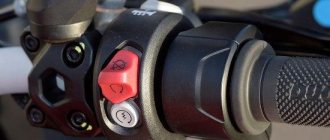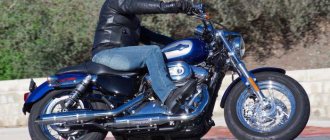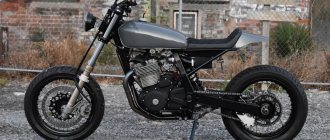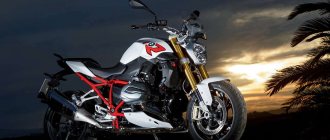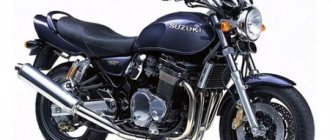Gone are the days when the “Big Goose” – the R 1200 GS – reigned as a monopolist in the touring enduro segment. Now that competitors have demonstrated their vision of a large adventure, against their background the heavy 1200 cc GS, and even with its archaic air-cooled boxer engine, no longer looks as chic as it did a few years ago. Something had to be changed.
The Bavarians understood this perfectly, but were in no hurry. On the one hand, there was a huge army of conservative fans on the scales, and on the other, an equally large group of potential buyers who would have bought the prestigious “Bavarian” if it had been more modern. Therefore, the long-planned upgrade of the model was carried out under the slogan “don’t scare off the old and attract new ones,” which in a certain way affected the final result.
The motorcycle has remained virtually unchanged in terms of concept and design, but has become completely new in terms of filling. I admit, when I first saw it, I was disappointed - it was the same rake, but with a new handle! However, once I dived into the technical part of the matter, my skepticism gradually began to disappear.
Yes, the power unit looks the same as before, but it now has a fundamentally new intake and exhaust system and a powerful liquid-oil cooling system. Yes, it seems like there is also the usual cardan drive with a cantilever pendulum, but now it is on the other side. And if you look closely, it’s structured completely differently. The shape of the light optics is recognizable, but now it is completely diode - a first in the motorcycle industry! All vital parts and components have changed.
I won’t bore you with detailed descriptions of these modifications, because any fan is much more interested in knowing how all this upgrade affected the driving performance. So let's test the new recruit in action! Fortunately, BMW Motorrad did not delay the test drive for long: a couple of months after the premiere, journalists were invited to South Africa, where even in winter you can race with the breeze both on asphalt and along picturesque dirt roads.
For testing, we were given the most fully equipped devices, so it took a lot of time to sort out everything. There are engine operating modes: Rain, Road, Dynamic, Enduro and even Enduro Pro. Taking into account the variations in the settings of traction control (four modes) and ABS (three modes), as well as the Dynamic ESA electronic dynamic suspension adjustment system, we get dozens of different options for the motorcycle’s operation!
FINISH
Visually, the motorcycle has changed little: the characteristic GS “beak” is in place
We poked our fingers at the buttons, turned the levers... In the end, the instructor helped us set the optimal mode. To confidently “play on the settings”, you need to drive more than one thousand kilometers in a variety of road and weather conditions. According to the instructor, even the most extreme modes do not deprive the motorcycle of its main qualities - a friendly attitude towards the pilot and adequacy. It was hard to disagree with this...
The “water” opposition began to work completely differently - quieter, softer and smoother. At idle, in terms of vibrations and noise, it is even perceived as a rower: the balancing is excellent! Although, as soon as you twist the throttle, the well-known twisting effect, characteristic only of boxer engines, appears. It has become easier to get underway, the clutch is softer and clearer, the gears also shift accurately, although it was not bad before.
The new direct-flow intake system makes itself felt by the instant response of the engine to turning the throttle. In general, the dynamics of this enduro are in perfect order. It takes off like one bitten, rushes forward up to 100 km/h, does not die after 150 km/h and shows its character at around 200 km/h. Super!
And the complex electronic filling, like an invisible assistant, controls the pilot. It stifles the engine a little where necessary, strengthens or loosens the suspension, and you have to try hard to get the wheel into the axle box. But the intervention is so subtle that your humble servant very often had the feeling that he had become the thunderstorm of the pampas. There were no obstacles or directions that I could not cope with!
Although, of course, driving 150 km/h along a dirt road in the dust behind a group of comrades was sometimes quite scary. In general, I must say, electronic suspensions are something with something! I have not yet ridden any enduro that could effortlessly “eat” the washboard of a grader and at the same time tenaciously hold on to the turns of the asphalt serpentine.
BMW style
From the outside it might seem that the 2018 BMW R 1200 GS Adventure looks exactly like its predecessor. But in fact, the guys from BMW plunged even deeper into history and brought back the original spirit of the GS. Look at the fuel tank, for example. The colors are new, but BMW has decided to take a step back and show off the massive fuel tank rather than disguise it with sleek styling elements. Of course, the pilot still has to spread his knees wide, but this is nothing special unless the surrounding terrain forces you to brake hard. But if you have 500 kilometers to go, then you will appreciate this return to the roots of the GS. In addition, there is now a small glove compartment above the fuel tank. The elongated nose looks more massive, and the fairing of a complex structure and the windshield form a uniform barrier, which means they better protect the driver. The faux air intakes are still in place as before, but are now even more noticeable due to the large amount of plastic surrounding them. The BMW R 1200 GS Adventure embodies its signature design, expressed in asymmetrical headlights. Only this time the lighting fixtures have LED bulbs. The air intakes and side panels of the fuel tank have received a new design. In place of most of the miniature body parts are the crash bars, which are now part of the standard equipment and protect the fuel tank and engine.
As an optional package (for a fee of course), you can equip your motorcycle with the following components: Keyless Entry, High Rallye seat, LED auxiliary lights and much more. But most importantly, the bike now has a stunning new instrument panel. It comes with an optional 6.5-inch TFT color display, which connects via Bluetooth to your smartphone for an even wider range of possibilities. The motorcycle's steering wheel is designed to be as functional as possible and not distract the pilot from driving. It has many dual-mode switches, the functionality of which you quickly understand and remember. It turns out that you literally have control of the on-board computer at your fingertips; you can independently set up travel modes, even if the sun is shining directly in your eyes. You can install an Emergency Call feature on your motorcycle, which, as the name suggests, will call emergency services to your location in the event of an accident. Crash and roll angle sensors can distinguish between serious accidents and minor rollovers.
Competitors.
Triumph Tiger Explorer XCa
Triumph Tiger Explorer XCa
The Triumph Tiger Explorer XCa is based on the Tiger Explorer XC, but retains the typical adventure riding position and overall looks like an evolved baby Tiger 800 XCa. Compared to other models in the line, this Tiger has the richest equipment and is the most powerful utility motorcycle. The Tiger Explorer XCa features dual round headlights, which are inherited from the standard Tiger Explorer XC, as well as additional LED headlights. This Triumph is well prepared to handle the toughest terrain, with a skid bar behind the engine and special crankcase protection below the engine. Other equipment standard on the Tiger includes: cruise control, 12V power outlets, heated steering grips, steel radiator guard, hill control, two additional riding modes: Dynamic Sport and fully customizable Ride mode, heated seats , tire pressure monitoring system, running boards. The quality of the parts is excellent, as is always the case with Triumph motorcycles. The new Triumph Explorer XCa is powered by the same four-stroke, three-cylinder, in-line, 12-valve, liquid-cooled engine with a displacement of 1215 cm3. It is currently the largest engine in the adventure motorcycle segment in the world. Thanks to a six-speed gearbox, the engine produces 135 hp and 142.4 Nm of maximum torque. As with all utilitarian motorcycles, power is transferred to the rear wheel through a shaft. The front suspension is an inverted telescopic fork with tubes with a diameter of 46 mm, the rear suspension is a monoshock absorber with a remote oil reservoir.
Both circuits are represented by equipment manufactured by WP. With almost 190mm of vertical suspension travel, the bike can handle the worst trail conditions or no trail conditions at all. The braking system on the Triumph Tiger (manufactured by Nissin) features dual front brake discs with a diameter of 310 mm and a single brake disc at the rear with a diameter of 285 mm. Both wheels are equipped with a switchable ABS system. In addition, the motorcycle comes with traction control and several riding modes.
Ducati Multistrada 1260.
Ducati Multistrada 1260
Ducati is conquering new heights as they have expanded their Multistrada family with the following models: Multistrada 1260, Multistrada 1260 S, Multistrada 1260 SD|Air (with airbag) and Multistrada 1260 Pikes Peak. All of them are equipped with a 1216 cm3 engine, a set of advanced electronic systems, a new chassis and various functions for long journeys. In addition to the new engine and chassis, the Multistrada 1260 family received new body panels, new, lighter, sports wheels. The 1260 has an unmistakable face with a teardrop-shaped twin headlight with a curved, V-shaped line. S modifications also have Ducati cornering headlights.
The Multistrada 1260 model is equipped with an LCD instrument panel, while the S model and higher variants are equipped with a 5-inch TFT screen. The new Ducati Multistrada1260 is powered by the same Ducati Teststretta DVT twin-cylinder engine (cylinders positioned at an angle of 90 degrees) as the standard Multistrada. However, the piston stroke increased from 67.9 mm to 71.5 mm. Maximum power of 158 hp is achieved at 9500 rpm and 129.5 Nm of torque at 7500 rpm.
At the same time, 85% of the total power is achieved already at around 3500 rpm. And this means that the Multistrada boasts the highest effective torque in its class. The new Multistrada 1260 received the chassis from the 1200, but it was modified. The frame now has a longer swingarm and wheelbase, which has a positive effect on the geometry. Controllability and stability have increased, the pilot feels more confident. The 1260 features Kayaba 48mm inverted forks and a Sachs monoshock.
For other models, the front suspension functions are taken over by a Sachs 48 mm fork. Braking duties are handled by a twin 320mm disc with radial four-piston Brembo Monoblock caliper at the front and a 265mm disc with twin-piston shock absorber at the rear. Finally, the Bosch IMU inertial platform interfaces with the Ducati Skyhook Suspension (DSS) control system, which can be adjusted on the fly.
Technical characteristics of BMW 1200 gs
| Engine volume, cm3 | 1170 |
| Power, hp | 125 |
| Number of cylinders | 2 |
| Number of cycles | 4 |
| Maximum speed, km/h | More than 200 km/h |
| Gasoline consumption, l | 4,1-5,5 |
| Tank volume, l | 20 |
| Transmission | 6-speed |
| Dimensions, mm | 935/1450/2210 |
| Weight, kg | 229 |
A powerful boxer engine allows you to get out of any conditions. It provides maximum power by increasing torque and enhancing traction. The injection system also affects engine performance. The engine is started using an electric starter.
The suspension can be adjusted in a standard way. The front one can be set to one of five positions using a set of keys. The rear mono shock absorber is adjusted using a special tap located under the seat. Telelever and Paralever front and rear suspensions provide good road stability. These suspensions are designed specifically for BMW and are also used on some other models. Transmission – manual, six-speed. The main gear is cardan.
The ABS system together with carefully designed brakes make the ride safe.
Flaws:
- High price category and cost of service.
- High requirements for the quality of consumables.
- Most parts are expensive to replace.
- The instrument panel is unfinished - the numbers on the electronic speedometer are difficult to read due to its small size. In addition, the speed is determined in miles and kilometers, which, if you’re not used to it, is very distracting and you can make a mistake.
Despite certain shortcomings, the BMW 1200 GS bike can confidently be considered one of the best developments of the BMW company. Everything about it helps make your trips easy, comfortable, and memorable. As with all developments, safety, comfort and reliability come first. Photos of the BMW 1200 GS motorcycle demonstrate unsurpassed style and grace. This technique pushes you to make long trips and conquer new heights of mastery.

